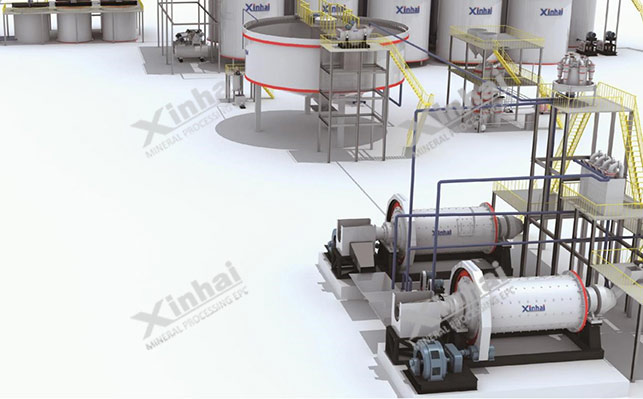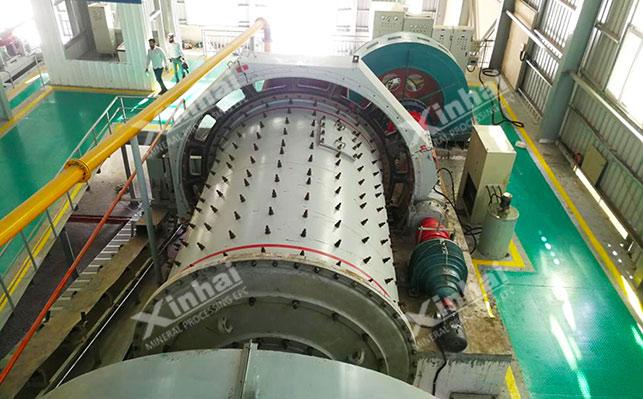
15311826613
Click to add WeChatBoth molybdenum and iron are important mineral resources in China, but the general grade of molybdenum deposits in my country is low and the reserves are small. Although iron ore has large reserves and many deposits, it mostly exists in the form of "poor, fine and mixed". In order to economically and efficiently recover molybdenum and iron minerals, it is very necessary to target the resources of difficult-to-select and fine-grained minerals. This article will introduce a molybdenum-iron type mineral and analyze the beneficiation process for recovering molybdenum and iron at the same time.
The mineral is mainly composed of silicate minerals and aluminosilicate minerals. The main metal minerals in the ore are molybdenite and magnetite, followed by hematite, ilmenite, pyrite, chalcopyrite, galena, etc. The main gangue minerals are quartz, feldspar, amphibole, sericite, followed by calcite, chlorite, titanite, fluorite, talc, rutile, and carbonaceous materials, etc.

Among them, the main usable elements are molybdenum and iron, with grades of 0.12% and 5.87% respectively. The oxidation rate of molybdenum is not high. Iron is mainly found in silicate minerals, and there is less iron in magnetite. The content of other metals is relatively low, and the content of silicon and aluminum in the rock-forming components is relatively high.
Through mineral analysis, it is determined that the target metal mineral in the ore is molybdenite, and the content of other metal sulfide minerals is very low, and it is not worth recycling at present. The flake sericite, layered talc, carbonaceous materials, copper, lead and other sulfide ores in the ore will affect the quality of molybdenum concentrate and need to be dispersed and suppressed; in addition, the ore also contains a small amount of magnetite that can be comprehensively recovered. If you want to effectively recover molybdenum and iron, you need to improve the floatability of molybdenite in the mineral and reduce the mixing of floating gangue minerals and sulfide impurities such as chalcopyrite and galena into the molybdenum concentrate.

There are some intergrowths in molybdenite in the mineral. If the monomer dissociation is difficult under coarse grinding conditions, the flotation efficiency of molybdenite intergrowths needs to be enhanced during flotation. Therefore, the efficiency can be improved by using a combined collector; the embedded particle size of magnetite is mainly fine and micro-fine. If roughing is used, it is difficult to achieve the monomer dissociation effect, so the re-selection of coarse concentrate should be reduced as much as possible.
Finally, after the analysis of the ore dressing test, the coarse grinding flotation tailings discarding-molybdenum coarse concentrate regrinding and concentrating-flotation tailings magnetic separation iron selection-iron coarse concentrate multi-stage regrinding-multi-stage concentrating process was designed for the molybdenum iron ore.
Coarse grinding flotation tailings discarding of molybdenum iron:The coarse grinding flotation tailings discarding process of molybdenum iron is mainly to recover molybdenum from the ore. Because the grade of molybdenum ore is low, it is necessary to flotate and recover molybdenum under coarse grinding conditions. Molybdenum has good natural and floating properties. When the exposed molybdenite containing 1% is used with an appropriate collector, it can float smoothly.

Molybdenum rough concentrate regrinding and concentrating: The principle process of molybdenum flotation is one-stage rough grinding and tailings - two-stage molybdenum regrinding - eight-time concentrating. Rough concentrate regrinding and scrubbing technology are added in the two-time concentrating process to create conditions for obtaining high-quality molybdenum concentrate products through multiple concentrating. Since the molybdenum rough concentrate contains a certain amount of ore mud, and there are also some gangue minerals such as pyrite and sericite with good floatability, the ore mud will be further increased after regrinding, which seriously affects the next step of improving the grade of molybdenum concentrate. Therefore, a concentrating operation is set before regrinding.
Magnetic separation of flotation tailings for iron selection: The tailings after flotation of molybdenum ore contain a certain amount of magnetite, and the embedded particle size is fine and uneven. In order to effectively recover part of the magnetite, the ferromagnetic separation one-stage roughing-two-stage regrinding-three-time concentrating process is designed.

Iron rough concentrate multi-stage re-grinding-multi-stage selection: After obtaining the iron rough concentrate, in order to further purify it, the iron rough concentrate obtained after re-selection was subjected to a multi-stage grinding-multi-stage magnetic separation process. When the re-grinding fineness of the iron rough concentrate reaches 95%-25μm, the iron concentrate grade can reach more than 64%, the operation recovery rate reaches more than 46%, the flotation tailings yield is 1.65%, the flotation tailings recovery rate is 18.34%, and the magnetite recovery rate is 78.61%.

For the molybdenum iron ore, the process of first flotation and then magnetic separation was adopted, and finally the molybdenum concentrate grade of 52.62% and the recovery rate of 85.88%, the iron concentrate grade of 62.23% and the recovery rate of 76.61% were obtained.
The above mainly introduces the characteristics of a molybdenum iron ore and its molybdenum iron ore dressing process and flow. In the actual beneficiation process, how to choose the ore process plan depends on the mineral properties. Therefore, it is recommended to conduct a beneficiation test first, and design a suitable molybdenum and iron ore beneficiation process according to the test analysis. At the same time, the suitable iron ore dressing equipment type can also be determined according to the process plan.